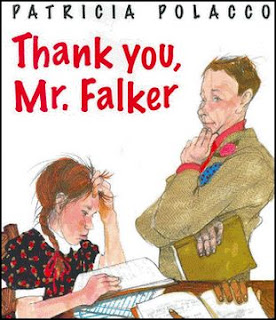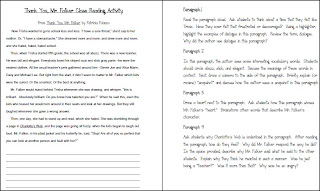One of the new terms that has emerged from the Common Core national standards is "close reading." At first, I confused this was "cloze" reading passages I learned about in my reading method courses in college. However, I quickly learned that "close" reading is just a term implying the detailed - or close - look at a passage. Close reading encourages students to think deeper, to ask questions, to make inferences, to evaluate and to predict. Many close reading strategies are referred to in middle school ELA standards, but close reading can begin in kindergarten!
I am going to try to incorporate a close reading activity each week in my weekly reading "schedule." While I strive to implement many of these activities on a regular basis, I want to intentionally take some time each week to look closer at just a page or small passage from a story or text. I tried my own close reading activity with my new fourth graders the first week of school. Using highlighters, colored pencils and a copy of the book,
Thank You, Mr. Falker, students were highly engaged and eager to participate.
I am teaching ELA for half of the fourth grade team at my school, so I wanted to introduce our class with a book that would share my philosophy on reading with my new students. I love any Patricia Polacco book, but Thank You, Mr. Falker, is one of my favorites. It is an inspiration to any child, but particularly to students who have difficulty or struggle with reading. In the book, the author (Tricia), manages to struggle through school (being promoted grade level after grade level) without learning to read. She grows increasingly frustrated, embarrassed and develops a hatred for school. Finally, when she is in fifth grade, a new teacher (Mr. Falker), approaches her learning in a different way and helps her to discover that she has dyslexia and CAN learn through more appropriate strategies. Obviously she learns, as she grows up to be an acclaimed children's book author and illustrator! I read the book, emphasizing many of Mr. Falker's philosophies, and helping students to connect to Tricia by launching dialogue about times that they have felt frustrated, embarrassed, discouraged, etc. I also encouraged them to think about times that they have made others feel that way. I then launched into our own attitudes and behaviors in my reading class, and how we will treat and encourage one another.
After the book reading and talk, I passed out the "close" reading page (just the student page) and guided students through a closer look at one particular section of the book. Finally, we closed with a questioning page (what is a question you had before you read, two questions you had during reading and a question you have now that you have read the book). I was impressed with their thinking and responses! They were truly active participants and excited throughout each phase of the lesson. Most importantly, I feel that I created a tone of positive acceptance and confidence for ALL readers in my room.
I have attached the close reading activity and a questioning page I used. Feel free to use it in your classroom or file it away for future use!
Questioning Activity
Mr. Falker Close Reading
















.JPG)